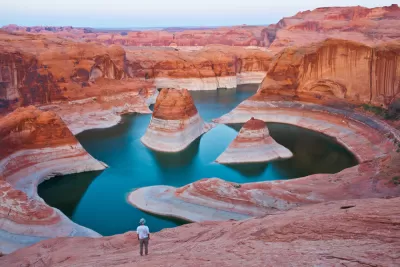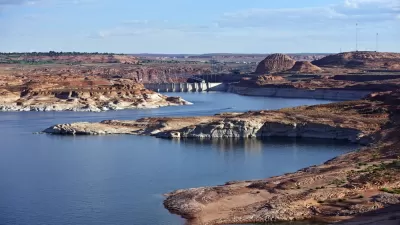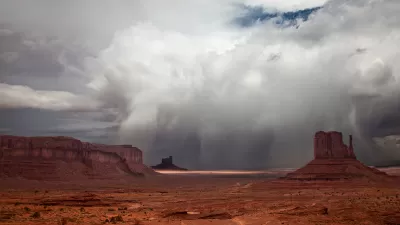In an interview with Lincoln Institute of Land Policy, former Arizona Governor and former Secretary of the Interior Bruce Babbit recommends new approaches to the challenges facing the Colorado River watershed.

Dr. Jim Holway, director of the Babbitt Center for Land and Water Policy, interviews former Arizona Governor and former Secretary of the Interior Bruce Babbit on the subject of the Colorado River.
Here are a few highlights from the interview:
- "The first challenge is to recognize that we live in a desert with huge and rapid climatic fluctuations. Across the twentieth century, we built the great system of reservoirs to store water against these fluctuations. But our assumptions regarding climate change and population growth were way off. We are now drawing more than a million acre-feet out of reservoir storage each year in excess of average inflow. And obviously that cannot continue. We must now work toward establishing balance across the entire basin. To get to that equilibrium will require adjustments from every water user: agricultural, municipal, power generation, and environmental uses. And it obviously can’t be done on a piecemeal, ad hoc basis; we’ll have to invent new processes of public involvement and shared adjustments from every town and city and farm in the basin."
- "In the West, connecting and integrating land and water use is a relatively new idea. Water use, like land use and zoning, has traditionally been a local affair, with little coordination or direction at the state or interstate level. But water is a common resource; developing on a local, project by project basis without thinking about regional supply and demand constraints inevitably leads to the crises and environmental degradation that we are now experiencing. The question is how to change that."
FULL STORY: Colorado River Reflections

Planetizen Federal Action Tracker
A weekly monitor of how Trump’s orders and actions are impacting planners and planning in America.

San Francisco's School District Spent $105M To Build Affordable Housing for Teachers — And That's Just the Beginning
SFUSD joins a growing list of school districts using their land holdings to address housing affordability challenges faced by their own employees.

The Tiny, Adorable $7,000 Car Turning Japan Onto EVs
The single seat Mibot charges from a regular plug as quickly as an iPad, and is about half the price of an average EV.

With Protected Lanes, 460% More People Commute by Bike
For those needing more ammo, more data proving what we already knew is here.

In More Metros Than You’d Think, Suburbs are Now More Expensive Than the City
If you're moving to the burbs to save on square footage, data shows you should think again.

The States Losing Rural Delivery Rooms at an Alarming Pace
In some states, as few as 9% of rural hospitals still deliver babies. As a result, rising pre-term births, no adequate pre-term care and "harrowing" close calls are a growing reality.
Urban Design for Planners 1: Software Tools
This six-course series explores essential urban design concepts using open source software and equips planners with the tools they need to participate fully in the urban design process.
Planning for Universal Design
Learn the tools for implementing Universal Design in planning regulations.
Smith Gee Studio
City of Charlotte
City of Camden Redevelopment Agency
City of Astoria
Transportation Research & Education Center (TREC) at Portland State University
US High Speed Rail Association
City of Camden Redevelopment Agency
Municipality of Princeton (NJ)





























